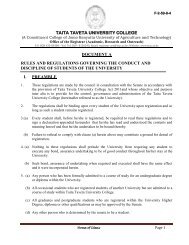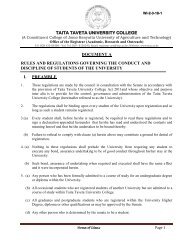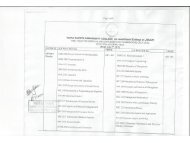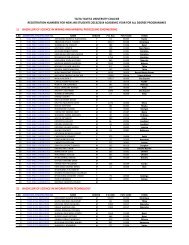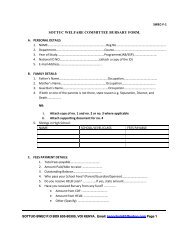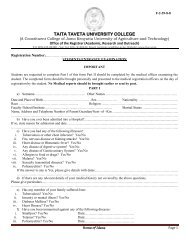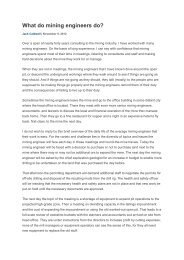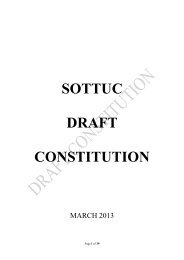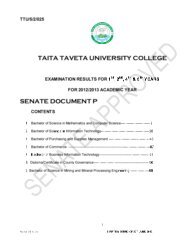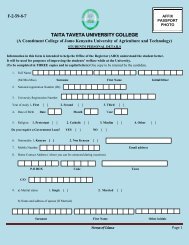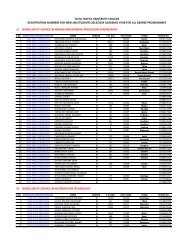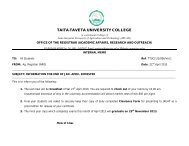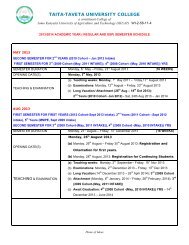Conference Book of Abstracts - Taita Taveta University College
Conference Book of Abstracts - Taita Taveta University College
Conference Book of Abstracts - Taita Taveta University College
- No tags were found...
Create successful ePaper yourself
Turn your PDF publications into a flip-book with our unique Google optimized e-Paper software.
Establishing a “Microbial–Plant” Interface As a Means to Control Rice Blast DiseaseNjiruh Paul Nthakanio 1* , Kanya James Ireri 2 , Kimani John Munji 3. Wajogu Rapheal Kinyanjui 41 Kenya Polytechnic <strong>University</strong> <strong>College</strong>, Department <strong>of</strong> Biochemistry and Biotechnology. Po Box 52428-00200Nairobi. Cell phone +254720487126 Email: nnpanj@yahoo.com2 <strong>University</strong> <strong>of</strong> Nairobi, School <strong>of</strong> Biological sciences, P.O. Box 30197, Nairobi. Cell phone +2540722307387:Email: jiykaya@uonbi.ac.ke3 Kenya Agricultural research, Institute (KARI), P. O. Box 298, Kerugoya, 10300; Tel: +254-202028217, or Box402-10303 Wang’uru. Cell phone +254729853035; E-mail: kimanijm@yahoo.com4Mwea Irrigation Agriculture Development (MIAD) Centre. Unyunyuzin House, Lenana Road Nairobi; Cell phone+254722865449; Email: wanjogurk@yahoo.comAs evidenced by recent food donations and incidences <strong>of</strong> hunger, Kenya is faced with seriousfood insecurity. To reverse this, there is need to increase food crop productivity or yield perhectare. This will involve plant genetic transformation, disease control and improvement <strong>of</strong>agronomic practices. One way <strong>of</strong> increasing rice yield without increasing the acreage under rice(Oryza sativa L.) cultivation is the use <strong>of</strong> hybrid rice technology. Two genetically fixed varietiesare cross-pollinated to produce filial generation one (F 1 ) or hybrid seeds. Even with this rice blast(Pyricularia grisea) continue to erode yields and its is responsible for over $5 billion in yieldloss. In ongoing project we intend to produce hybrid rice that is resistant to blast. Our mainobject to create a microbial-plant interface that enables transfer <strong>of</strong> high yield and blast resistancegenes such as RCC2 ha into rice plant using Agrobacterium tumefaciens. Additionallyhybridization, by exploiting rice plant diversity and heterosis, will bring about a multi-geneinterplay under a single rice plant hence further boost in blast resistance. Material to be utilizedwill be rice plants; Basmati370; Photoperiod sensitive geneic male sterile (PGMS); andThermosensitive genic male sterile (TGMS). PGMS and TGMS are sterile when grown underlong day-light length and high temperature conditions respectively and revert to fertility innormal day-light length and low temperature growth conditions. Te develop biological guardagainst P. grisea bacteria (Actinomyctes, Bacillus and Pseudomonas) and fungal antagonists(Trichoderma spp., Penicillium, Myrothecium verrucaria, Chaetomium globosum and Laerisariaarvalis) will be used while nitrogen fixing bacteria Rhizobium oryzae sp. Nov. will be includedto test ability <strong>of</strong> rice to fix nitrogen. Methods to be used will include isolating bacteria fromvarious soil samples that will be assayed through serial dilution. Bacteria will be multiplied inbroth medium and their single and combined effects against P. grisea will be evaluated inlaboratory and field conditions. Successful combination will be tested and packaged forcommercial use. To exploit plant genetic diversity in blast resistance, Basmati 370 will bebackcrossed with blast disease PGMS/TGMS varieties up to BC 4 F 1 and then anther culture willbe done to fixed the genes using doubled haploid approach. These will be used as male parents tobe cross with blast disease PGMS/TGMS in hybrid rice seed production programme.Additionally, bacterium <strong>of</strong> rhizobium genus (Rhizobium oryzae sp. Nov) will be inoculated inBasmati with a view <strong>of</strong> determining its efficacy to fix nitrogen in Basmati370 rice backgrounf.Pollen from F 1 will be cultured to produce callus which will be transformed by co-cultivationwith Rhizobim spp with an aim to regenerating plantlets with nitrogen fixing ability. Ourexpected product is high yielding hybrid Basmati370 that is disease resistant (or guarded to blastdisease attack). This will increase farmers‟ income and food security in this Country.



